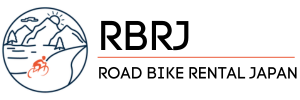
Visión general y guía de Kyoto en bicicleta: Moverse en bicicleta
이 교토 사이클링 가이드는 교토와 그 주변에서 자전거를 타는 것에 대해 알아야 할 거의 모든 것에 대한 개요를 제공합니다.
Índice
- 교토를 자전거로 여행하는 이유 >
- 교토 레이아웃 >
- 팁 및 도로 규칙 >
- 자전거 대여 >
- 자전거 경로 >
- 자전거 주차장 >
- 사이클리스트가 알아두면 유용한 정보 >
- Reflexiones finales >
교토에서 자전거를 타는 이유
교토에는 자전거를 탈 수 있는 멋진 장소가 많습니다. 산을 오르고, 깊은 숲을 탐험하고, 강을 따라 페달을 밟고, 그림 같은 마을을 지나고, 시내에서 최고의 에스프레소를 찾아 크루즈를 타고 시내를 돌아다닐 수 있습니다.
자전거를 타고 탐험할 때는 A 지점과 B 지점뿐만 아니라 도중에 계획에 없던 예상치 못한 일들도 볼 수 있습니다.
자전거를 타면 훨씬 더 많은 것을 볼 수 있습니다.
숨겨진 보석

시내와 주요 명소의 인파는 꽤 부담스러울 수 있지만 다행히도 교토에는 도심과 주요 관광지 바로 너머에 자연의 경이로움과 매력이 숨어 있습니다.
산으로, 골목길로, 한적한 교외로, 시골 농촌 마을로 라이딩을 떠나면 잘 알려진 길만 고집해서는 얻을 수 없는 일본의 독특하고 진정한 면모를 발견할 수 있습니다.
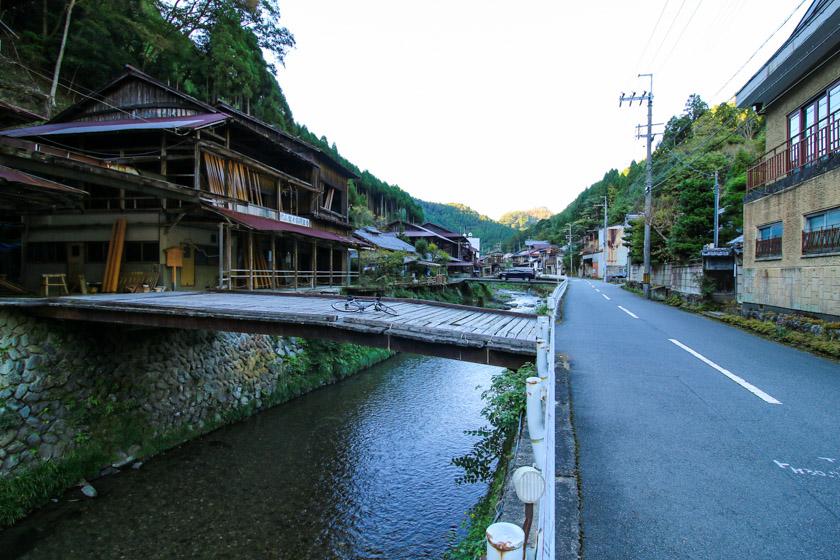
가이드북에는 없는 신사, 사원, 강, 그리고 말 그대로 시골과 외딴 지역으로 모험을 떠날 때 우연히 발견하게 되는 일본 본연의 멋진 풍경이 너무나도 많습니다.
로드바이크 렌탈 재팬에서는 사람들이 일본에 머무는 동안 이러한 순간을 더 많이 경험할 수 있도록 돕는 것을 사명으로 삼고 있습니다.
멋진 자연

일본은 정말 아름다운 나라입니다. 하지만 때로는 세계적으로 유명한 문화 명소와 도시의 화려한 네온사인이 그 아름다움을 가릴 수 있습니다.
우뚝 솟은 가파른 산, 아래를 가로지르는 강과 계곡, 일본에서만 볼 수 있는 독특한 매력을 지닌 시골 농촌 마을, 구석구석에 자리 잡은 신비로운 지역 신사, 온몸을 삼킬 것 같은 광활한 숲, 라이딩 도중에 옷을 벗고 뛰어들고 싶어지는 바다와 해변이 있습니다.
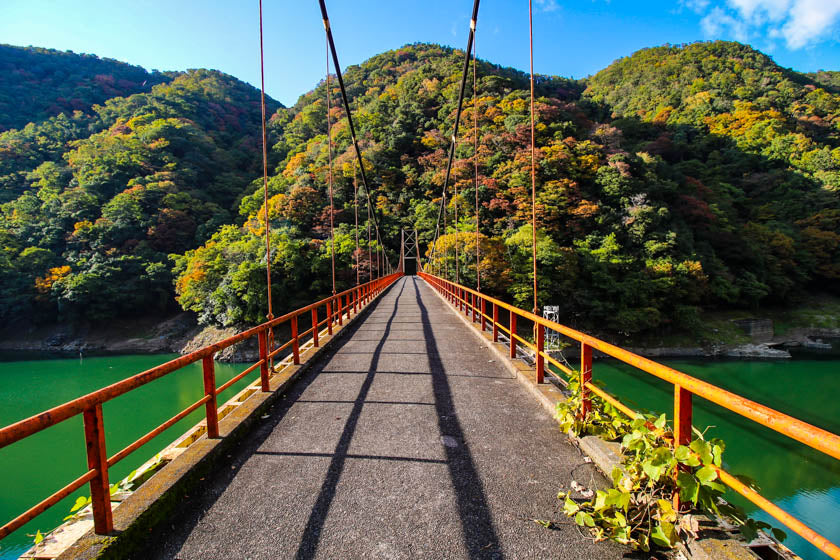
If you catch trains and buses everywhere you can miss a lot of this. However being on a bike gives you the best chance of discovering the real natural beauty of Japan and we’re sure you won’t be disappointed.
속도

자전거는 걷는 것보다 빠르기 때문에 걸어 다닐 때보다 적은 노력으로 더 많은 거리를 이동할 수 있습니다.
번잡한 지역에서는 자전거에서 내려서 걷는 것이 더 나을 때도 있지만, 보통은 자전거를 타면 더 빨리 이동할 수 있고 머리에 부는 바람을 즐길 수 있습니다.
재미있고, 건강하며, 환경에도 좋은

자전거를 타는 것은 재미있어요. 그 이유를 설명하는 과학적 설명은 많지만, 페달을 돌리고 혈액을 순환시키며 엔도르핀이 분비되면 기분이 좋아지는 것은 당연한 일입니다.
운동은 기분을 좋게 해주고 자전거 타기는 휴일에 과식하고 마시는 것의 균형을 맞출 수 있는 좋은 방법이기도 합니다. 일본의 음식은 훌륭하고 현지 레스토랑에서 맥주를 자유롭게 마실 수 있으며 여행 중에 운동을 하면 기분이 좋아질 수 있습니다.
자전거 타기는 화석 연료를 최소한으로 사용하며 공해가 없는 교통수단입니다.
기후 변화는 전 세계가 직면한 가장 큰 도전 과제이며, 트위터는 가능한 모든 방법으로 탄소 배출량을 줄이기 위해 노력하고 있습니다.
교통수단으로서 자전거를 타는 것은 환경에 더 좋으며, 이런 가이드가 사람들이 자전거로 교토를 돌아다니도록 장려하는 데 작은 역할을 하기를 바랍니다.
교토 레이아웃
교토는 계곡에 있으며 서쪽, 북쪽, 동쪽에 산으로 둘러싸여 있으며 아타고 산은 924m로 가장 높은 봉우리입니다.
Kyoto sits southwest of the largest freshwater lake in Japan, Lake Biwa, however none of the lake actually comes into Kyoto prefecture with the entire body of water sitting in Shiga prefecture.
이 가이드에서 교토를 언급할 때 교토시라는 의미는 훨씬 더 큰 교토부가 아닌 교토시를 의미합니다.
교토시는 교토 부의 수도로 교토 부 전체 면적의 약 18%를 차지하는 도시입니다.
When we think about cycling around Kyoto, it’s helpful to break up the city into sections which are listed below:
- 교토 북서부
- 교토 북동부
- 서쪽 교토
- 동쪽 교토
- 교토 남서부
- 교토 남동부
- 교토 시내 및 중심가
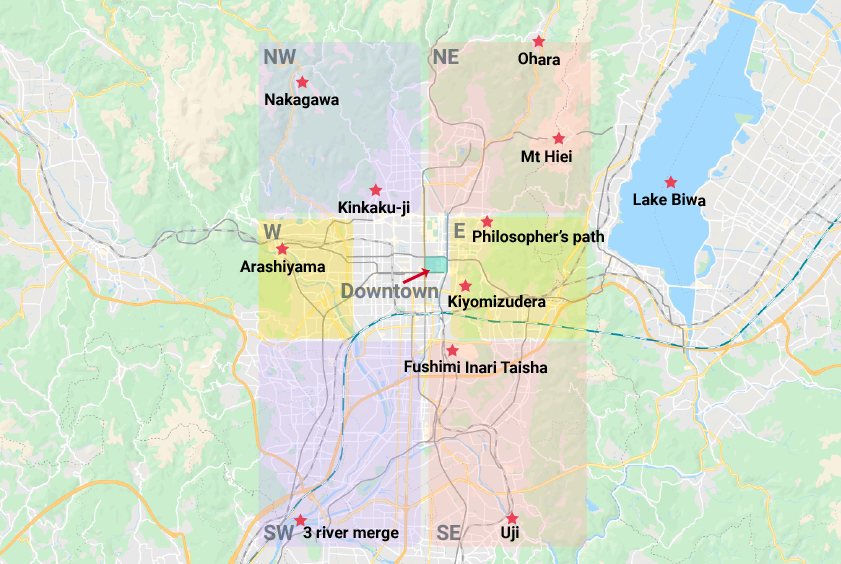
교토 중심부 및 시내
다운타운은 서쪽의 가라스마도리, 북쪽의 오이케도리, 동쪽의 가모강, 남쪽의 시조도리가 경계를 이루고 있습니다.
The area is pretty small – 1km squared – making it easy to walk around.
While not everyone follows the rules, cycling on the below streets are prohibited:
- 가와라마치도리, 오이케도리와 북코지도리 사이
- 시조도리, 히가시오지 도리와 가라스마 도리 사이
- 기야마치도리와 가와라마치도리 사이의 산조도리
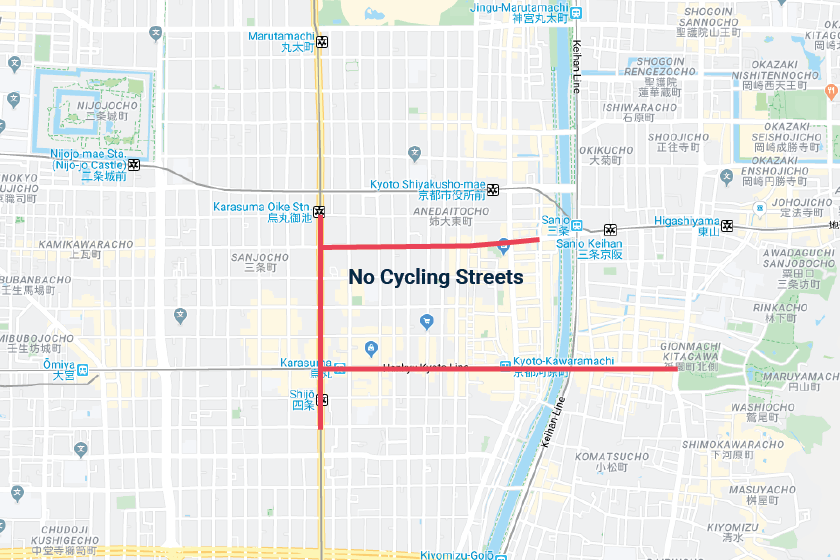
Apart from the prohibited streets (and other streets that are restricted at certain times of the day or during certain events during the year), you can ride around and navigate Kyoto city fairly easily due to the grid layout. It should be noted there is a fair bit of traffic on the roads making peak hours a pretty congested time to cruise the streets.
There are also a lot of traffic lights – especially in the city centre around downtown – making the going pretty slow in some areas.
또한 일상을 보내는 현지인과 매년 교토를 방문하는 수많은 관광객으로 구성된 유동인구도 문제입니다.

도시를 돌아다닐 때 강은 거리의 교통 체증과 공해를 피할 수 있는 유용한 방법입니다. 도심이나 교토 동쪽에 있다면 가모 강을 따라 라이딩을 즐길 수 있고, 서쪽에 있다면 가쓰라 강을 따라 라이딩을 즐길 수 있습니다.
West Kyoto – Katsura river and Arashiyama
서쪽의 가쓰라 강은 자전거를 타고 탐험을 시작하기에 좋은 출발점입니다.
Hay un carril bici a lo largo del río y el paseo tiene momentos preciosos para disfrutar mientras se pedalea.
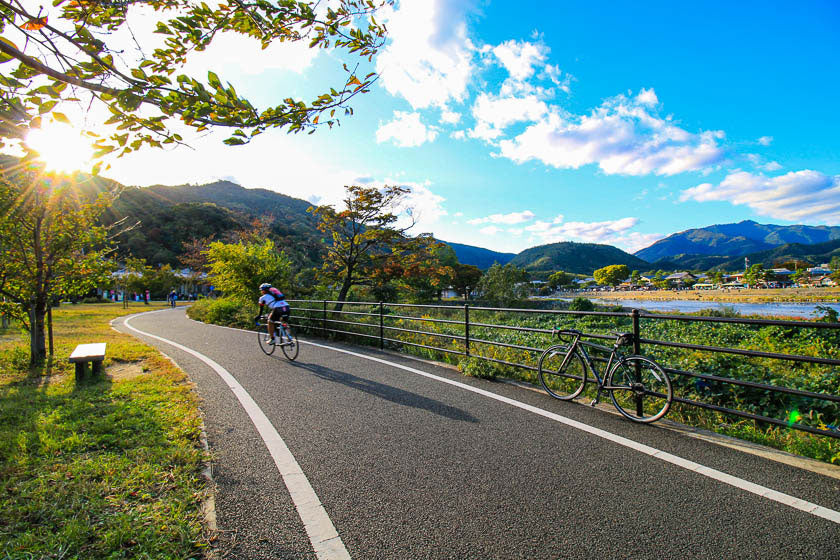
Puede empezar más al sur y dirigirse hacia Arashiyama o empezar en Arashiyama o Matsuo Taisha y dirigirse hacia el sur.
Arashiyama es una parte especial del mundo pero, como otros lugares de Kioto, se llena de turistas. El bosque de bambú, en particular, está muy congestionado, por lo que las primeras horas de la mañana o las últimas de la tarde son el mejor momento para visitarlo.
Una de las mejores partes de pedalear por Arashiyama no es pedalear por Arashiyama en sí, sino por el sendero del río que se dirige hacia el norte en dirección a Arashiyama. Las montañas serpentean por las crestas a medida que la mundialmente famosa zona se va revelando poco a poco en la distancia.
Norte de Kioto
Dividimos el norte de Kioto en secciones noroeste y noreste.
Noroeste - Montañas a Umegahata, Nakagawa y más
Las montañas del norte son impresionantes. Ofrecen subidas, bajadas, pueblecitos de postal y vistas y olores nítidos del bosque y el paisaje.
일본의 소나무는 아름답고 산으로 들어가면 광활한 숲으로 인해 고립된 듯한 야생의 느낌을 받을 수 있습니다.
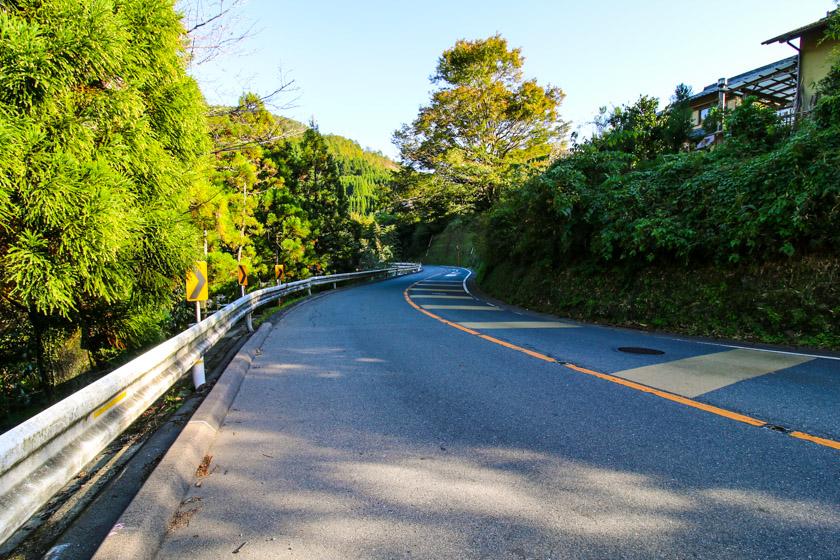
Las montañas del norte son de fácil acceso desde la ciudad, ya que a las rutas del noroeste se suele acceder al norte de Arashiyama y a través de Umegahata.
Northeast – Ohara and Mt Hiei and more
Hay numerosas zonas para recorrer en bicicleta y explorar en el noreste, siendo Ohara un centro neurálgico para muchas de las rutas de la zona.
Ohara es un simple paseo por la 367 justo después del parque del estanque de Takara-ga-ike y la estación de Takaragaike.
Las carreteras de montaña también suben, atraviesan y sobrepasan el monte Hiei, más al este.
El monte Hiei es la segunda montaña más alta de Kioto, y hay algunas subidas importantes si quiere esforzarse y acelerar el corazón.

Si se sube y cruza la montaña se desciende hasta el lago Biwa, también muy popular entre los ciclistas.
동쪽 교토
El este de Kioto se considera probablemente la otra orilla del río Kamo y la zona incluye algunos de los lugares más famosos y visitados de Kioto.
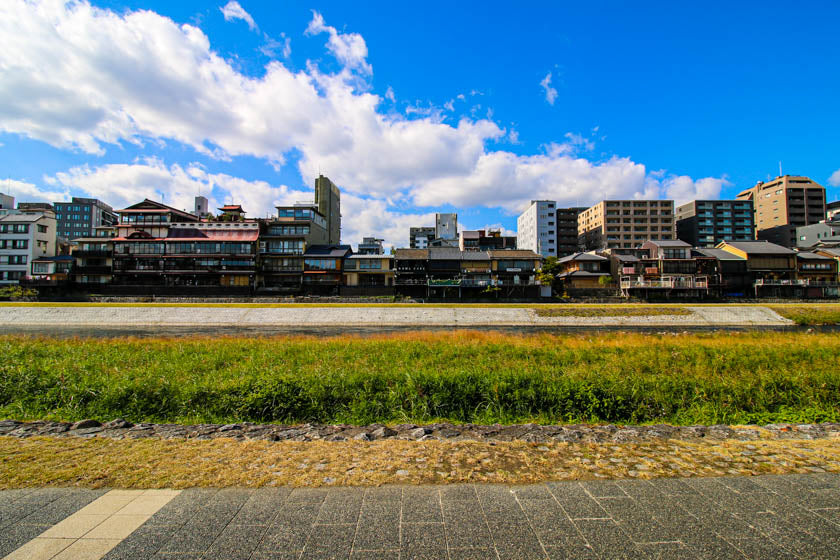
Encontrará el camino del Filósofo directamente al este de la Universidad de Kioto, Nanzen-ji al sur de allí y el templo Kiyomizu dera más al sur de nuevo.
En el este se practica mucho ciclismo, y muchos turistas recorren la encantadora zona de Higashiyama disfrutando de las vistas.
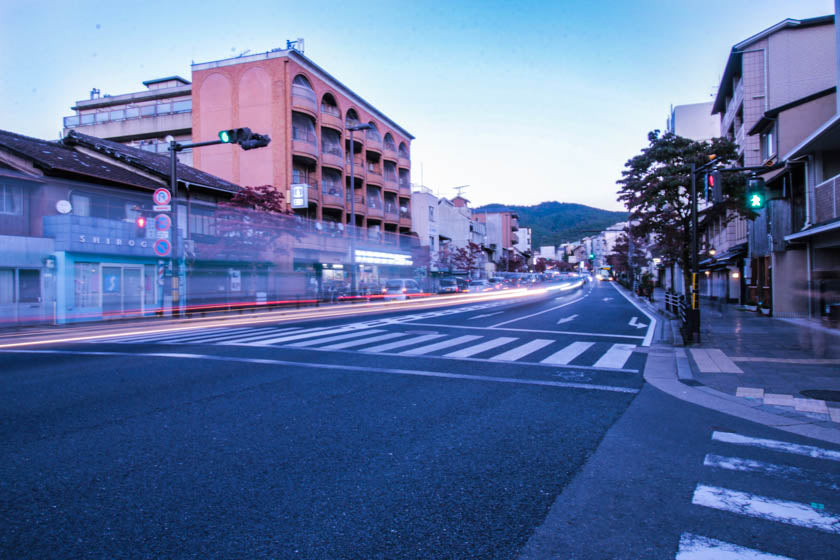
Si lo desea, puede tomar el Sanjo dori colina arriba, pasando por la estación de Keage y por detrás de Kiyomizudera, para acabar en Otsu.
Puede haber mucho tráfico alrededor de la estación de Shinomiya, el intercambiador de Kyoto Higashi y a lo largo de la ruta 1 hasta Otsu, así que evite las horas punta si puede para disfrutar más del viaje.
Sur de Kioto
El sur también se divide en secciones suroeste y sureste.
Sureste - Uji y hacia Nara
Las rutas y zonas del sureste también ofrecen algunas zonas maravillosas para ir en bicicleta. El santuario de Fushimi Inari es un lugar precioso para visitar, pero hay que recorrerlo a pie, así que si quieres visitarlo llega pronto para evitar las aglomeraciones.
El viaje a Uji es una de las rutas obligadas para los ciclistas que deseen disfrutar de un paisaje impresionante.
El trayecto hasta Uji fue bastante bueno, con algunas partes urbanas interesantes pero algunas carreteras con algo de tráfico. Sin embargo, una vez que se llega a Uji y se empieza a remontar el río Uji y luego el Seta, cualquier idea de tráfico desaparece rápidamente.

La carretera que bordea el río es espectacular.
Las sinuosas carreteras son un auténtico placer para la bicicleta, y las espectaculares vistas del río y los puentes a lo largo del recorrido constituyen una fantástica experiencia ciclista.

Para ver la ruta y leer más sobre el recorrido en detalle, consulte nuestra sección Rutas ciclistas de la guía.
El sudeste suele ser el punto de acceso para descender a Nara, un recorrido clásico que no decepciona. La ruta incluye espesos bosques, carreteras ribereñas, granjas, fauna salvaje (ciervos en Nara) y algunas subidas épicas.
También puede encontrar un enlace a un bucle de Kioto a Nara en la sección Rutas ciclistas.
Southwest – Katsura river, three river confluence
El sur de Kioto también es popular entre los ciclistas, ya que suele ser la puerta de entrada de los que se dirigen a Osaka por el río Yodo o a Nara por el río Kizu.
En el sur se encuentra la confluencia de tres ríos: el Katsu, el Uji y el Kizu, que se funden en el Yodo.
Desde allí se puede descender por el río Kizu más al sur hasta Nara, tomar el río Uji hacia el este o saltar al río Yodo y hacer el trayecto hasta Osaka.
Encontrará información detallada sobre las rutas en la sección Rutas ciclistas de la guía.
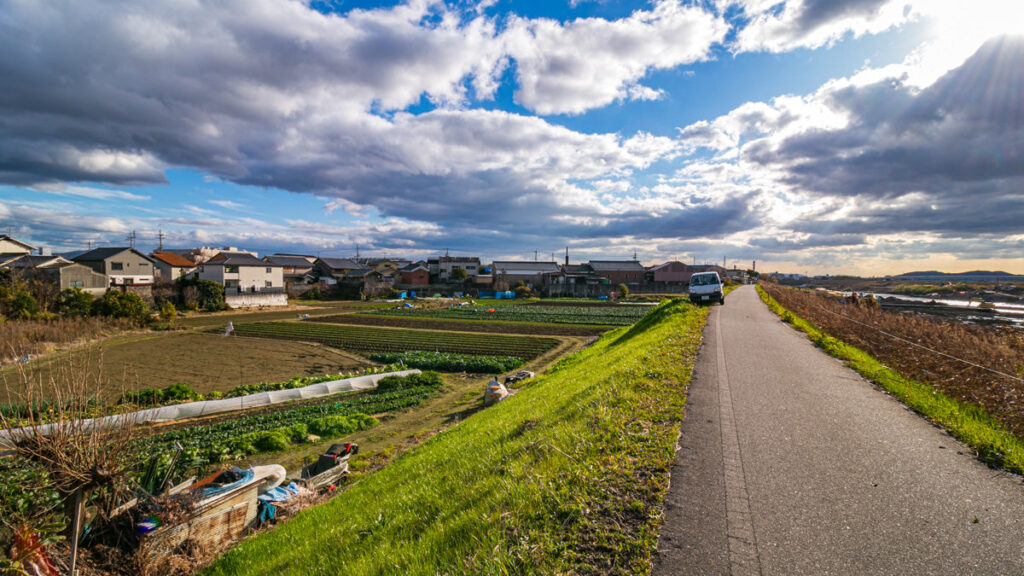
Consejos y normas de circulación
Circular por la izquierda

En Japón se circula por la izquierda. Esta es la regla número uno para los ciclistas que llegan a Japón, porque si vienes de un país en el que se conduce por la derecha, te costará un poco acostumbrarte.
¿Sendero o carretera?

You should always stay to the left of the road unless there is a dedicated cycling path which you should then use. You can actually cycle on the footpaths / sidewalks in Japan pretty freely but there is actually a law stating that you can ride on the footpath if there is a signpost saying it’s possible.
Having said this, you’ll see a lot of people riding on footpaths in Japan so we don’t think you would ever be stopped by police unless you were trying to cycle through the middle of a really busy thoroughfare for pedestrians
Cascos

Recientemente han cambiado las leyes japonesas que obligan a todos los ciclistas a llevar casco. En RBRJ, siempre recomendamos el uso del casco, pero se dará cuenta de que la mayoría de las personas que circulan en bicicleta por las ciudades y los suburbios no lo llevan.
Para que te sientas cómodo, siempre puedes traerte el casco de casa, pero si no es así, la mayoría de las tiendas de alquiler deberían proporcionarte un casco con el alquiler de la bicicleta.
¿Es seguro montar en bici?

En general, Japón me parece un lugar bastante seguro para ir en bicicleta.
Parece haber mucha menos agresividad por parte de los conductores que en Occidente, y los conductores tienden a entender y a tener más en cuenta a los ciclistas. Creo que esto tiene algo que ver con el hecho de que la mayoría de la gente que conduce también va en bici. Puede que no sean ciclistas de carretera, pero probablemente tengan una bicicleta urbana con la que van al supermercado, a la estación de tren o a su barrio.
Por supuesto, todavía hay algunos conductores agresivos en Japón, así que mantén la concentración y peca de defensivo cuando circules entre el tráfico y no tendrás ningún problema.
Alquilar una bicicleta
Alquilar una bicicleta en Kioto es bastante fácil. Hay muchos lugares que alquilan las bicicletas urbanas básicas y las tarifas diarias no son tan caras.
Los hoteles también tienen a veces un servicio de alquiler de bicicletas para los huéspedes, así que consulte con su alojamiento, ya que es posible que el alquiler de bicicletas esté incluido en la habitación.
La bicicleta básica que transporta a la mayoría de la población local en su día a día se llama Mamma-chari. Se trata de una bicicleta de una sola velocidad con una cesta en la parte delantera.
Si desea una bicicleta con algunas marchas, existen varias opciones, muchas de ellas con manillar plano.
En el caso de las motos de carretera y deportivas, la oferta es mucho más limitada.
En RBRJ, estamos especializados en motos de carretera y de paseo de alto rendimiento y también disponemos de una sólida gama de motos de paseo.
Para ver la gama de bicicletas de carretera y de paseo, consulte el siguiente enlace:
Gama de bicicletas de carretera y de paseo >
Rutas ciclistas
Hay muchas zonas diferentes por las que puede pasear en bicicleta en Kioto. Desde acercarse a la ciudad y los suburbios hasta salir de la ciudad y encontrar algunos bosques aislados y tranquilos pueblos rurales.
Para que te hagas una idea general de por dónde circulan los ciclistas en Kioto, echa un vistazo al siguiente mapa de calor de Strava: las líneas rojas indican la actividad ciclista.
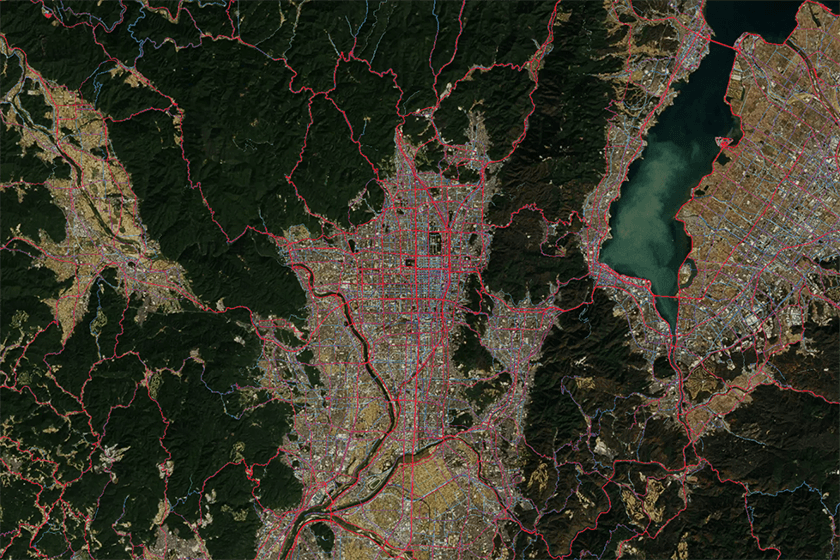
A continuación se muestran algunas rutas ciclistas de ejemplo que se dividen en:
- Rutas más cortas
- Rutas de longitud media
- Rutas más largas
Rutas más cortas
De Sanjo al Camino del Filósofo
Distancia: 4,6 km
Ganancia de elevación: 84m
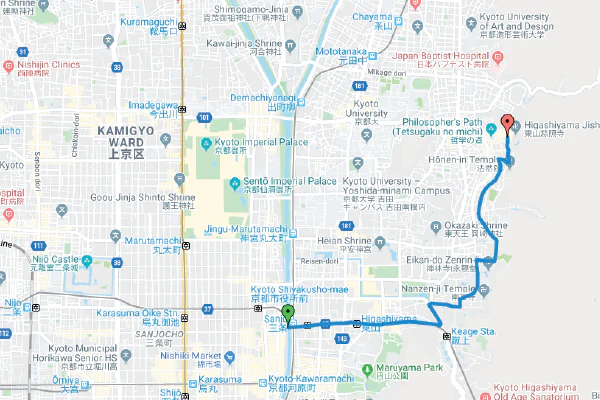
아라시야마에서 3강 합류점까지
Distancia: 20km
Elevación: 93m

중간 길이 노선
Northeast and Northern loop – Ohara and Kamo
Distance: 40.27km
Elevación: 474m
View route on Google maps >

Northwest mountains ride – Umegahata, Nakagawa
Distancia: 58km
Ganancia de elevación: 865m
View route on Google maps >
Link to route guide and blog

Kyoto to Osaka – Katsura and Yodo rivers
Distancia: 49km
Elevación: 308m
Link to route guide and blog >

장거리 노선
Kyoto to Uji to Otsu loop – return to Kyoto city
Distancia: 70km
Ganancia de elevación: 903m
Link to route guide and blog >

교토와 비와코 루프
Distancia: 218km
Elevación: 1,184m
Link to route guide and blog >

자전거 주차장
Considering the amount of people that ride bikes in Kyoto the bike parking isn’t particularly good.
A la hora de aparcar su bicicleta en Kioto, tiene prácticamente las siguientes opciones:
- 무료 스팟
- 유료 스팟
- 항상 피해야 할 장소
무료 스팟
덜 붐비는 지역에서는 일반적으로 자전거를 인도와 도로에 문제 없이 무료로 주차할 수 있습니다. 예를 들어 점심을 먹으러 식당에 들렀다면 자전거를 앞쪽에 주차하고 걱정 없이 식사를 할 수 있습니다.
레스토랑이나 쇼핑 센터에 고객을 위한 자전거 주차장이 있을 수도 있습니다.
여기서 중요한 점은 제한된 시간 동안 자전거를 주차한다는 것입니다. 편의점에 들어가서 몇 가지 물건을 산 다음 자전거를 다시 타면 금방 괜찮아질 것입니다.
하지만 자전거를 몇 시간 또는 며칠 동안 방치하면 겉으로 보기에 안전하고 자유로운 장소에서 자전거를 도난당할 가능성이 높아집니다.
유료 스팟
시내에는 대부분 무료로 이용할 수 있는 잠긴 주차 베이가 있습니다. 자전거를 넣고 잠길 때까지 기다렸다가 출발하면 됩니다. 돌아와서 기계에 자전거 주차 번호를 입력하고 보통 100엔 또는 200엔의 소액의 요금을 지불하면 됩니다.
일부 자전거 주차장은 주로 월별 또는 연간 요금을 지불하는 소유주를 위한 곳이지만, 일부 자전거 주차장은 소정의 요금을 지불하고 일일 주차도 허용합니다.
주차 금지
However, in busier parts of the city there are places where you shouldn’t park your bike, even for a few minutes. Places such as outside of main train stations, department stores, office buildings in the CBD and high-end shops are pretty regulated and you will find you will get a warning tag quickly followed by your bike taken if you don’t move it ASAP.
자전거를 도시 자전거 청소부에게 빼앗긴 경우, 자전거를 어디로 가져갔는지 알려주는 종이가 바닥에 붙어 있는지 확인하세요. 자전거 열쇠를 가지고 가면 유료로 자전거를 돌려받을 수 있습니다.
특히 고가의 자전거를 가지고 계신 경우 주차에 주의하실 것을 권장합니다. 호텔 근처에 유료 주차 구역이 있다면 그곳을 이용하고 자전거 잠금 장치도 사용하는 것이 좋습니다.
호텔에 자전거를 보관할 수 있는지 또는 자전거 주차장이 있는지 문의하는 것이 좋습니다. 일부 호텔에서는 자전거를 보관할 수 있지만 많은 호텔에서는 외부에 자전거 주차장을 찾으라고 요청하므로 이 경우 가까운 곳에 유료 자전거 주차장이 있는지 문의하세요.
사이클리스트가 알아야 할 유용한 정보
아래는 교토를 자전거로 여행할 때 알아두면 유용하거나 도움이 될 만한 몇 가지 정보입니다.
장비를 구매하거나 수리를 받을 수 있는 상점

와이 로드 교토
Y’s road Kyoto has a great range of bikes and parts and the staff are also pretty knowledgeable too. There is basic English assistance (depending on the staff member) and if you need repairs they are reliable and also not that expensive. Shop location here >
To be honest, the website is a bit of a mess and could really be improved a lot. Your best bet is to visit the store and have a look at the range and speak to staff if you need.
사이클링하기 가장 좋은 계절

교토에서 자전거를 타기에 가장 좋은 계절은 봄과 가을입니다. 여름과 겨울에도 자전거를 탈 수 있지만 여름에는 극심한 더위와 습도에 주의하고 겨울에는 영하의 기온으로 인해 도로에 눈이 내리고 위험한 빙판길이 생길 수 있으니 주의하세요.
봄
봄의 날씨는 아름답고 운이 좋으면 라이딩 중에 벚꽃을 볼 수도 있습니다.
3월은 여전히 약간 쌀쌀할 수 있지만 3월, 4월, 5월은 자전거를 타기에 환상적입니다. 5월은 3월보다 조금 더 따뜻하지만 벚꽃 시즌에는 많은 인파가 몰리기 때문에 일찍 예약하고 가능하면 피크 시즌을 피하는 것이 좋습니다. 시골이나 산악 라이드를 떠나면 시골 곳곳에서 멈춰 서서 그 광경을 감상하게 만드는 놀라운 벚꽃을 목격할 수 있을 것입니다.
See the below link for the temperatures in Kyoto in April 2023 >
가을 / 가을
가을은 자전거를 타기에도 환상적인 계절이며, RBRJ에서는 가을을 가장 좋아합니다. 가을의 색은 장관을 이루며 벚꽃보다 더 오래 지속되기 때문에 변화하는 색의 아름다움을 더 잘 감상할 수 있습니다.
가을은 자전거를 타기 좋은 날씨가 봄보다 조금 더 오래 지속되는 계절이기도 합니다. 9월 초에는 여전히 매우 더울 수 있지만 9월 중순부터 12월까지 일본은 자전거를 타기에 가장 좋은 날씨입니다.
See the below link for the temperatures in Kyoto in October 2023 >
Verano
여름에도 자전거를 탈 수 있지만 더위를 심하게 느끼는 분이라면 여름이 부담스러울 수 있습니다. 습도와 더위가 더해져 햇볕이 내리쬐는 날은 따가울 수 있습니다. 자전거를 타실 때는 주의하시고 휴식을 취하고 충분한 물을 섭취하세요.
See the below link for the temperatures in Kyoto in July 2023 >
Invierno
겨울에도 사이클링하기에 좋은 날들이 있으며 얼마 전에는 13도의 햇볕이 내리쬐는 날씨에 라이드했는데 모두들 사이클링하기에 이상적인 날씨라고 생각했습니다. 하지만 날씨가 매우 추워질 수 있고 적절한 장비를 갖추지 않으면 금세 불편함을 느낄 수 있습니다.
눈과 얼음이 내릴 가능성은 말할 것도 없으니 도로를 조심하고 미리 날씨를 확인하여 여행 일정을 계획하세요.
물론 고도가 높을수록 도로에 눈과 매우 위험한 얼음이 있을 가능성이 높으므로 산으로 향하는 경우 도로에 얼음과 눈이 있는지 잘 살펴보세요.
See the below link for the temperatures in Kyoto in January 2023 >
자전거 운송

If you want to take your bike on the train you can, however you need to cover it completely. To see our full blog post on taking your bike on the train in Japan please see the below link on our Osaka site:
Taking bikes on trains in Japan – guide and instructions on using a train bag >
타사 보험

In more and more prefectures across Japan third party property and person insurance is becoming mandatory for cyclists. Not only for local cyclists but also for visitors from overseas.
If you rent a bike check with the rental shop that the bike has third party insurance and if they don’t, we advise you find a place that does.
If you are bringing your bike from home you also need to insure yourself which can be tricky as it’s usually done in Japanese. 7/11 offers a pay as you go insurance and you can buy it from their kiosks in-store.
Ask the staff if they can help you get the insurance and hopefully you’ll get some English assistance.
All RBRJ bike rentals are covered for third-party property and person. You can find more details about the insurance from the below link:
비상 연락처

While in Kyoto and especially if you are cycling there is a chance that you might need medical services at a stage. While Japan is a very safe country and cycling here is also pretty safe, it’s good to prepare in case of an accident or injury.
주의해야 할 몇 가지 사항은 다음과 같습니다:
- 가까운 병원 또는 진료소 알아보기
- 의료비를 보장하는 여행자 보험에 가입했는지 확인하세요.
- Don’t assume the hospital is open late at night or on weekends
- 화재 및 구급차 신고는 119로 전화하세요.
- 110번으로 전화하여 경찰 요청
지역 병원 알아보기
Firstly, it’s good to check where your local hospital is.
If you have a more severe medical problem a larger hospital is better, however for common colds and less serious problems you can see a Doctor at a local clinic who will refer you to a hospital if they think it’s necessary.
여행자 보험
Make sure you come with travel insurance, especially if you plan on doing any cycling. Health care in Japan is excellent and also very affordable, however if you don’t have any insurance you’ll pay 100% and if it’s complicated treatment it can get very expensive.
Don’t assume hospital is open
일부 병원과 클리닉은 늦은 밤과 주말에도 문을 닫습니다. 병원을 방문하기 전에 Google에서 해당 병원이 문을 여는지 먼저 확인하세요.
긴급 전화 번호
일본에서는 구급차 및 화재 신고와 경찰 신고를 위한 별도의 번호가 있습니다. 구급차나 화재 신고는 119, 경찰 신고는 110으로 전화하세요.
보통 전화로 영어 지원이 제공되지만, 상담원이 상황을 이해할 수 있도록 긴장을 풀고 천천히 말하세요.
- 119 para bomberos y ambulancias
- 110 para la policía
Reflexiones finales
자전거를 타고 돌아다니는 것이 교토를 둘러보는 가장 좋은 방법이라고 생각하며, 이 가이드의 정보가 고대 수도에서 자전거를 타기로 결정하신 분들에게 도움이 되기를 바랍니다.
This guide will periodically be updated with new information for cyclists so if you have any ideas or useful links that we’ve missed, let us know in the comments and we’ll try and include them.
교토를 자전거로 돌아다니며 즐거운 시간을 보내시고 궁금한 점이 있으시면 언제든지 연락주세요!
